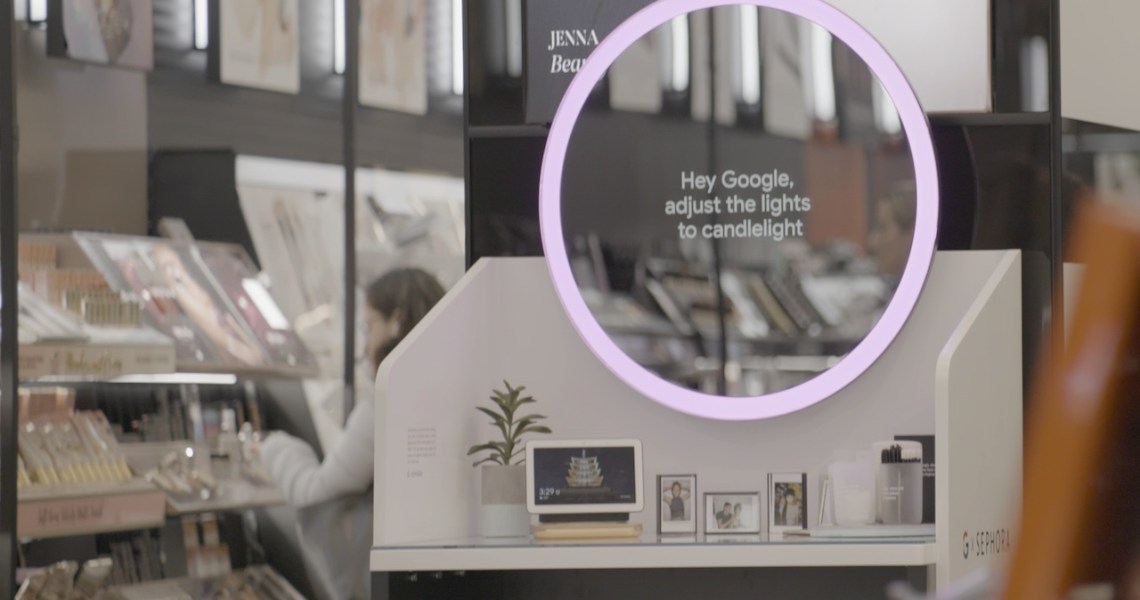In their first-ever partnership, Google and Sephora announced on Wednesday that they have brought Google Assistant and Sephora’s YouTube content together on the Google Home Hub voice assistant device, which launched in late October.
The Home Hub is a variation on Google’s voice assistant device called Home, which first launched in November 2016, and its smaller version, Home Mini. Its launch is a bid to compete with Amazon’s touchscreen-enabled voice assistant, Echo Show, and Lenovo’s version, Smart Display. Since November 2017, Sephora has had its app on Google Assistant, allowing people to book beauty services, take quizzes and listen to influencer-curated beauty podcasts. (Google is also working with brands like Disney and BuzzFeed Tasty on separate partnerships for Home Hub.) Tech companies including Facebook and Amazon have also been working more closely with beauty brands, and this partnership comes at a time when Google has recently laid out its plans to dominate the voice assistant category.
The idea is that Sephora customers can use the Home Hub at their vanities or in their bathrooms to access beauty tutorials through voice commands when their hands are otherwise occupied, according to Kristy Frivold, senior director at Sephora’s Innovation Lab. Google is using this partnership to help make Google Assistant more attractive and valuable to customers. According to a 2017 Pew Research Center study, only 8 percent of Americans use a voice assistant on a standalone device. Still, Sephora has not been the lone beauty brand to g there: Estée Lauder also partnered with Google Assistant on Google Home for a personalized nighttime skin-care routine through a series of questions, answers and product application suggestions.
For Google, the impetus for the Sephora-specific partnership was due to the “explosion” of beauty searches on YouTube, said Julia Chen Davidson, head of partner marketing for Google Home at Google — YouTube is owned by Google. The Home Hub’s main features rely on YouTube and Nest smart home integration (if a customer has it, although it is not necessary in order to operate the Hub), in addition to basic voice assistant commands asking for a weather report or music. Searches and views on Google and YouTube for beauty are up 65 percent year-over-year, according to CB Insights. Sephora, meanwhile, has over 1 million subscribers on the platform, which made the partnership “a natural fit,” Davidson said.
“We are introducing the smart display [capability] because it brings the value proposition of a smart speaker up a notch and provides hands-free help at a glance,” Davidson said. “Third-party partners [like Sephora] play a critical role in bringing this to life.”
Although this is the first formal partnership for the two companies outside of advertising, Google U.K. recently hosted an inaugural “Connected Beauty” event in October 2018, bringing together speakers from YouTube, Sephora, indie beauty brands and more to discuss trends across beauty. At the event, Google said there was an increase in searches for beauty products meeting specific consumer needs. Additionally, it found that using search data helped beauty brands like Maybelline and Clinique make consumer-focused decisions, according to CB Insights.
The Home Hub, which looks like a small tablet propped up on a base, is currently available on Sephora.com and will be available in-store at 10 flagship locations in Los Angeles, New York and Chicago. As part of the digital marketing plan for the Home Hub, Google will work with beauty and general lifestyle micro-influencers on Instagram such as Katya Bychkova (@Stylesprinter), who has 28,000 followers, and Lisa Elaine, (@Lisaelaine_) who has 12,500 followers.
Ad position: web_incontent_pos1
“We aren’t doing it just for tech or because it’s cool or new,” Frivold said. “We know our [customers] would love to have a beauty advisor in their home — like the ones they come to our stores for — and easier access to YouTube content.”




